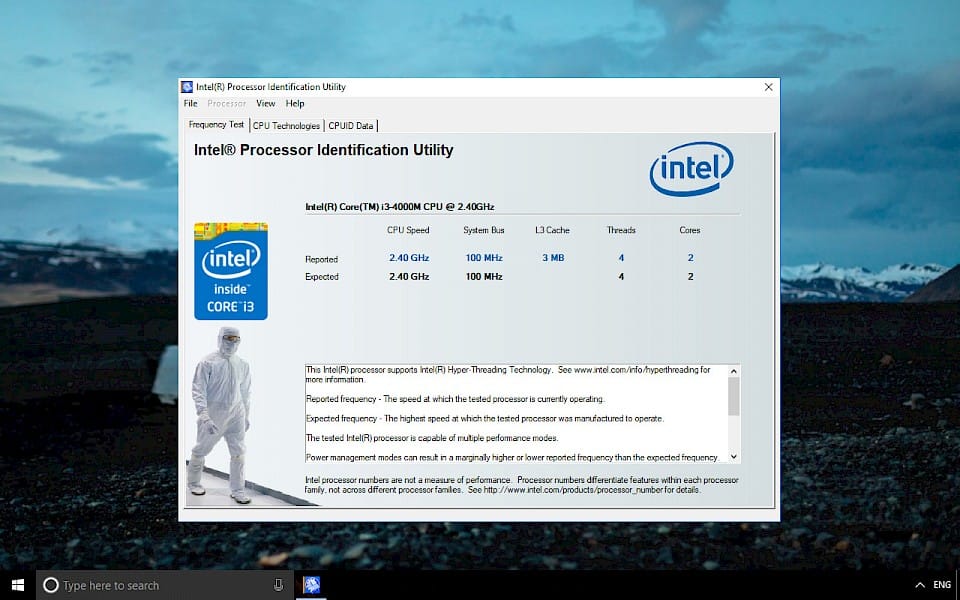

- INTEL PROCESSOR IDENTIFICATION UTILITY HYPER V PC
- INTEL PROCESSOR IDENTIFICATION UTILITY HYPER V DOWNLOAD
You can use it on your Windows 7 or Windows Vista PC to check if Hyper-V is supported on your system. Microsoft offers a utility named Microsoft® Hardware-Assisted Virtualization Detection Tool. Method 5: Use the Microsoft® Hardware-Assisted Virtualization Detection Tool (for Windows 7 and Windows Vista) But if you see a success page, it means your AMD CPU supports the technology. However, if it’s an AMD CPU and you get a message that says, “This utility did not detect an AMD processor,” then it means it does not support virtualization.
INTEL PROCESSOR IDENTIFICATION UTILITY HYPER V DOWNLOAD
Go to the download location and run the amdvhyperv.exe file.Download the AMD Virtualization™ Technology and Microsoft® Hyper-V™ System Compatibility Check Utility.If you have AMD Chipset, here’s what to do: Also, notice whether or not “Intel VT -x with Extended Page Tables” is active. If it is, then Intel Virtualization Technology is enabled on your computer. See if the “Intel Virtualization Technology” box is marked. Once open, click the CPU Technologies tab.Go to the download location and double-click the file to open it.Download the Intel® Processor Identification Utility.If you have Intel Chipset, here’s what you have to do: You have to use AMD’s utility if your CPU is AMD. Intel and AMD offer a utility tool with which you can check whether the virtualization technology is enabled on your computer. Method 4: Use the utility tool provided by Intel or AMD Under “Advanced Technologies” on the product page for your processor, you’ll see whetherIntel® Virtualization Technology (VT-x) is supported or not.Once on the site, enter the processor information you noted above in the search box located on the right-hand side of the page.Now, visit Intel’s product specification site () and follow these steps: In the window that opens, note the name of your processor as listed under the System category.Type in “System information” in the search bar and click the option from the search results.You need to obtain your processor details first. You can visit Intel’s product specification site to see if you have Intel VT-x. Method 3: Visit Intel’s product specification site If that’s the case, you’ll have to enable virtualization in your BIOS. However, the “Virtualization Enabled in Firmware” detail might show “NO”. If you see “Yes” for each detail, it means your CPU is virtualization-capable (could be either Intel VT-x or AMD-V). Once your system information is displayed, check the details under “Hyper-V Requirements”.Type or copy and paste the following command in the window that opens and press enter:.Type cmd in the text box and press enter or click the OK button.Press the Windows logo key + R to invoke the Run dialog.But you can find out if your CPU is capable of virtualization and if it is enabled. This method won’t show you whether you have Intel VT-x or AMD-V. Method 2: Enter a command in Command Prompt However, if you don’t find virtualization listed in the CPU specifications at all, it means it is not supported. If it is disabled, you’ll have to enable it in BIOS. On the bottom-right side of the screen, you’ll see whether your CPU supports virtualization and whether it is currently “Enabled” or “Disabled”.Once you open the Performance tab, your CPU information will be the first thing you’ll see. Note: You may not need to perform step 3.

You’ll find your processor type on the right-hand side of the window along with other details below. Select CPU from the pane on the left-hand side.Press Ctrl + Shift + Esc to launch Task Manager.If you are running Windows 10, Windows 8, or Windows 7, follow these easy steps: Use the Microsoft® Hardware-Assisted Virtualization Detection Tool (for Windows 7 and Windows Vista).Use the utility tool provided by Intel or AMD.Visit Intel’s product specification site.There are a handful of methods you can use to do so. This can be done from within the Windows operating system. You can check whether your PC supports virtualization technology or not and whether it is enabled. On new computers that use UEFI in place of BIOS, VT-x or AMD-V can easily be enabled within Windows by an application that wants to run it. Virtualization has to be enabled in the system’s BIOS on older computers. Most new PCs (desktops and notebooks) do so. Your processor type will be displayed there.įor virtualization to work, your computer has to support it on the hardware level. You’ll find your system information in the window that opens. Press the Windows logo key + X to invoke the WinX menu.What you have to do is check whether your CPU is AMD or Intel. You may want to know the hardware virtualization your computer comes with, whether Intel VT-x or AMD-V.


 0 kommentar(er)
0 kommentar(er)
